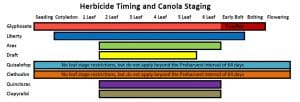A few days of summer-like conditions have weeds thriving, taking up nutrients and topsoil moisture. Whether canola is already emerging, seeded but not emerging, or not yet seeded, now is a good time to remove that costly weed competition. Here are some options for each of those three situations.
Pre-seed burnoff. Fields with a large population of weeds, especially advancing winter annuals, should get a pre-seed burnoff sooner rather than later. Even if you don’t see that many weeds, those weeds present now will be more damaging to yield than any weeds that emerge later. They’re also easier to control when they’re small.
Seeding can occur fairly soon after spraying. For annuals and winter annuals, glyphosate needs only 24 hours to get to the growing point and set the control process in motion. After a day, the crop can be seeded. For perennial weeds, the recommended delay ranges from three to five days depending on weather conditions. If sunny and warm, translocation will take place fairly quickly so 72 hours (three days) should be enough.
Post-seeding, pre-emergence. If pre-seed burnoff is missed, one option is to apply glyphosate (or glyphosate with an appropriate tank mix partner) in the narrow post-seeding/pre-emergence window. Shallow seeded canola can emerge within five days under warm and generally moist soil conditions, and since growers need to leave weeds for a couple days to start growing again after the seeding operation, you many only have a couple of days to spray within this window. The time lag between seeding and spraying is necessary to allow weeds buried by the seeding operation to re-emerge and to allow weeds uprooted to overcome the stress placed on them. However, spraying and missing a few of these weeds could be more beneficial than waiting to spray in-crop – but check for crop emergence before applying products that need to be applied pre-emergence.
Post emergence. Benefits of early weed removal — from the one- to four-leaf stages of the canola crop — are supported by numerous research studies across Western Canada. This early control allows the crop to get established, and controls early emerging weeds before they take up excessive nutrients and moisture. Also, weeds that emerge after the crop has reached the four-leaf stage are usually so far behind the crop they will have little impact on yield, and contribute very little to the weed seedbank.

Check what’s out there in terms of weed numbers, sizes and species. This will determine the product choices and rates. If you’re in a field that got a pre-seed burnoff done, check that the weeds are dying as expected. If not, try to figure out why. Was it a sprayer miss? Could the weeds have emerged after you sprayed? Are they possibly resistant to the product applied?
What else to look for?
While out checking for weeds, take a look at emergence results and drill performance. If you’ve seeded cereals and haven’t got to the canola, look at seed depth and seed distribution row to row. If you notice any problems with drill performance, such as uneven depth, this would be a good time to solve them before seeding canola.
Check the topsoil moisture situation for fields that will be seeded soon. Scratch down to see what seeding depth would be required to place the seed on or into moisture. If more than 1-1/2″, the best move for canola is to seed shallow (1/2”) and wait for rain. You can also check the moisture situation in fields that are already seeded. Did winds dry out the seed bed, leaving seeds stranded without moisture? This could lead to uneven emergence across the field.
As canola emerges, note areas with atypical uniformity or missing seedlings, but save your final emergence counts until at least the two- to four-leaf stage. Missing seedlings can be the result of many factors, including excessive or misplaced fertilizer, insects like cutworms (or even woolleybear caterpillars!) Go through this list to identify the cause of missing seedlings and make notes of things to improve.
Finally, keep an eye out for flea beetles on germinating plants or on canola volunteers in fields that have not been seeded. Note that seeding 1/2″ to 1” deep into warm, moist soil should result in rapid crop emergence, helping ensure optimum performance from seed treatment. Conditions which lead to slow, uneven emergence (like cold or dry soils) could increase the risk of economic damage from flea beetles.
